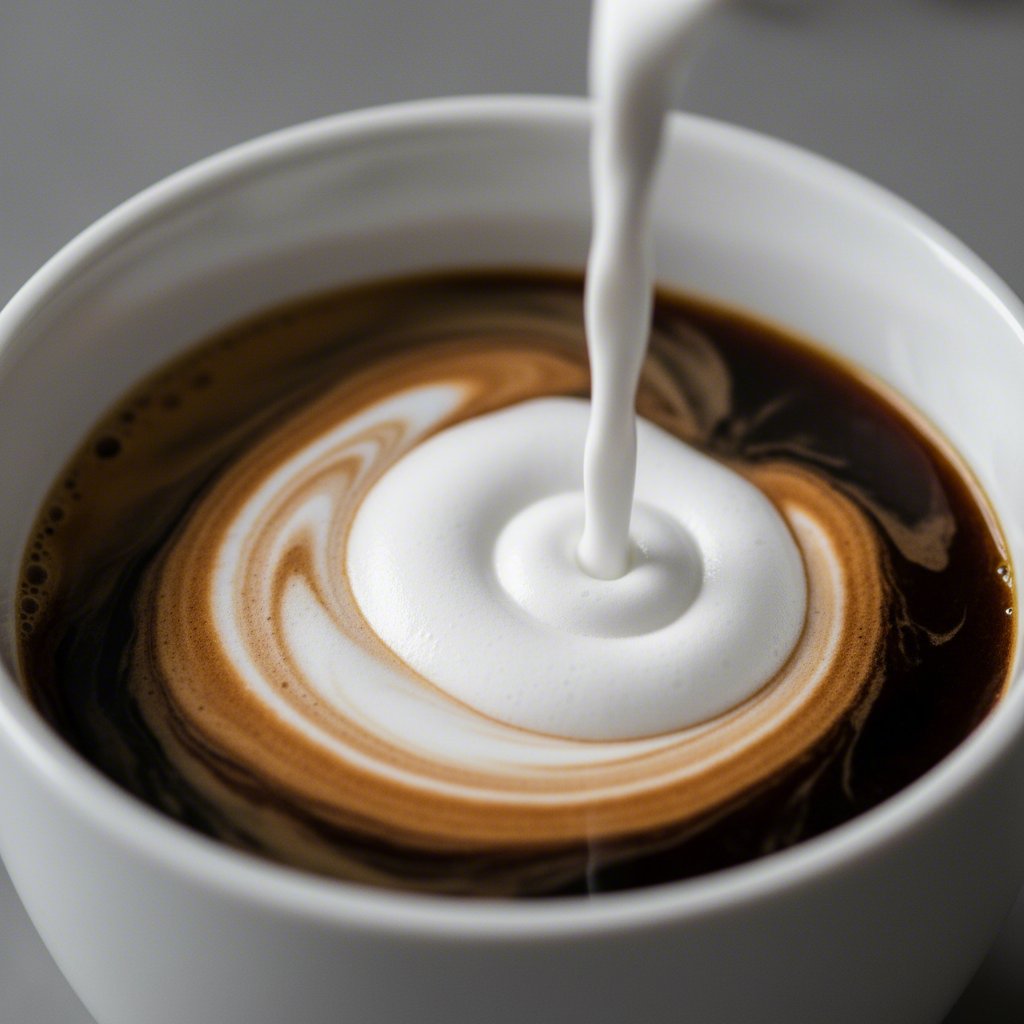TL;DR
Soy milk is one of the best plant-based alternatives for frothing because its high protein content creates a stable, creamy foam similar to dairy. For café-quality results at home, choose unsweetened or ‘barista series’ soy milk from brands like Pacific Foods or Westsoy. The key to success is proper technique: always start with cold milk and avoid overheating it past 131°F (55°C) to prevent curdling and ensure a perfect microfoam for your latte or cappuccino.
Why Soy Milk Is a Top Choice for Frothing: The Science Explained
The secret to a perfect, velvety milk foam lies in a delicate balance of protein and fat, and this is where soy milk truly shines among plant-based options. Frothing, or steaming, works by injecting hot air into milk. This process forces the protein molecules, which are normally coiled up, to unravel. As they unravel, they wrap around the air bubbles, creating a stable structure we call microfoam. According to an article from Latte Art Guide, milks with higher protein content are typically better for frothing, as they provide more building blocks for a durable foam.
Soy milk’s protein content is remarkably similar to that of cow’s milk, which is why it performs so well. Nespresso experts note that when frothed correctly, these high protein levels create a delicious froth much like dairy milk. While protein builds the foam’s structure, fat contributes to its texture and mouthfeel. Fat molecules destabilize the foam slightly, which prevents it from becoming too stiff or dry, resulting in the silky, creamy consistency desired for latte art. Whole dairy milk is often considered the gold standard for its ideal fat-to-protein ratio, but soy milk is widely regarded as the top non-dairy contender for its ability to replicate this effect.
To put it in perspective, here’s how soy milk’s protein content often compares to other popular plant-based milks:
| Milk Type | Typical Protein Content (per serving) |
|---|---|
| Soy Milk | ~7-8 grams |
| Oat Milk | ~3-4 grams |
| Almond Milk | ~1-2 grams |
This higher protein content is the fundamental reason baristas often reach for soy milk. It provides the necessary structure to build a luscious, lasting foam that holds up well when poured and enhances the coffee-drinking experience.

The Best Soy Milk Brands for a Perfect Froth: A Comparative Review
Not all soy milks are created equal, and the right brand can make the difference between a flat, disappointing coffee and a café-quality masterpiece. The best options generally fall into two categories: ‘barista series’ milks, which are specially formulated with additives for stability, and ‘purist’ milks, which contain minimal ingredients for a cleaner taste. Barista editions, like the popular Pacific Foods Barista Series Soy, are designed to withstand high heat and create consistent, velvety microfoam, making them a favorite among professionals.
For those who prefer fewer ingredients, brands like Westsoy Organic Unsweetened and Edensoy Unsweetened are excellent choices. As noted by Coffeeness, these products often contain just organic soybeans and purified water, offering a pure flavor profile. While they can be slightly more challenging to froth perfectly due to the lack of stabilizers, they reward the user with a clean, authentic taste. Another widely available option is Silk, which is praised by Urnex for its high protein content that contributes to a rich foam.
For those who desire ultimate control over ingredients and freshness, making plant-based milk at home has become an increasingly popular option. Looking to craft fresh, additive-free plant-based milks right in your kitchen? Soy Milk Quick offers an expert, comprehensive guide to the best plant milk makers for every need and budget, featuring detailed comparisons, pros, and cons. This approach allows you to avoid preservatives and tailor the milk to your exact frothing preferences.
To help you choose, here is a comparison of popular soy milk brands based on key frothing criteria:
| Brand | Key Characteristics | Best For |
|---|---|---|
| Pacific Foods Barista Series | Formulated with stabilizers for consistent, reliable foam. Slightly sweetened. | Beginners and those seeking café-style reliability. |
| Westsoy Organic Unsweetened | Minimal ingredients (soybeans, water). Neutral flavor. | Purists who want clean taste and no additives. |
| Edensoy Unsweetened | Similar to Westsoy, made with organic soybeans and water. | An alternative purist option with a clean profile. |
| Silk Unsweetened | High protein content, widely available, and foams well. | A versatile, everyday choice for reliable results. |
Ultimately, the best brand depends on your priorities. If you value consistency and ease of use, a barista series is your best bet. If you prefer a natural product and are willing to practice your technique, a purist, unsweetened soy milk will deliver excellent flavor.
How to Froth Soy Milk Perfectly: Techniques and Common Mistakes to Avoid
Choosing the right soy milk is only half the battle; mastering the frothing technique is essential for achieving that silky, creamy foam. The most common mistake is overheating, which causes soy milk to curdle. According to baristas at Latte Art Guide, soy milk has a lower heat threshold than dairy and should not be heated above 131°F (55°C). Exceeding this temperature will denature the proteins, leading to separation and a clumpy texture when it hits the hot espresso.
Another crucial tip is to always start with cold, refrigerated milk. As outlined in a guide by Nespresso, cold milk allows you more time to introduce air and create a vortex, which breaks down large bubbles into the fine microfoam needed for latte art. Shaking the carton before pouring also helps distribute the proteins and fats evenly. Whether you’re using a steam wand on an espresso machine or an automatic frother, the goal is to introduce air briefly at the beginning and then submerge the wand to spin the milk until it reaches the desired temperature and texture.
Here are the essential steps for frothing soy milk perfectly:
- Start Cold: Pour chilled soy milk directly from the refrigerator into your frothing pitcher.
- Shake Well: Give the soy milk carton a vigorous shake before pouring to ensure its components are well-mixed.
- Aerate Briefly: If using a steam wand, introduce air for just a few seconds at the surface to create foam. For an automatic frother, simply start the cycle.
- Spin to Smooth: Submerge the steam wand and create a whirlpool effect to break down large bubbles and integrate the foam, creating a smooth, glossy texture. Stop immediately when the pitcher becomes too hot to touch comfortably.
- Watch the Temperature: Use a thermometer to ensure you do not exceed 131°F (55°C).
- Pour Slowly: Pour the frothed milk into your espresso at a steady, slow pace to prevent splitting and allow for latte art.
By following these steps and avoiding the common pitfall of overheating, you can consistently produce delicious, creamy, and stable soy milk foam that rivals any coffee shop.
Soy Milk vs. Other Plant-Based Milks: A Frothing Showdown
While soy milk is a fantastic choice for frothing, it faces stiff competition from other popular plant-based milks, primarily oat and almond. Each has distinct characteristics that affect its frothing performance, texture, and flavor profile. Understanding these differences can help you choose the perfect non-dairy milk for your coffee.
Oat milk is celebrated for its creamy texture and neutral, slightly sweet flavor that closely mimics dairy milk. Its popularity has surged, especially ‘barista edition’ versions, which contain added oils and stabilizers to produce a rich, velvety microfoam. However, standard oat milks can be inconsistent due to lower protein content compared to soy. While they excel in creaminess, the foam may not be as structurally stable as that from soy milk.
Almond milk, on the other hand, is generally the most challenging of the three to froth well. It has the lowest protein and fat content, which makes it difficult to create and sustain a dense foam. The resulting froth is often thin, with larger bubbles that dissipate quickly. Barista-grade almond milks are fortified with additives to improve performance, but they still tend to produce a lighter foam than soy or oat. Its subtle, nutty flavor is a plus for those who don’t want the milk to overpower the coffee’s taste.
Here’s a head-to-head comparison to help you decide:
| Feature | Soy Milk | Oat Milk (Barista Edition) | Almond Milk (Barista Edition) |
|---|---|---|---|
| Froth Stability | Excellent (High Protein) | Good (Relies on Additives) | Fair (Low Protein) |
| Creaminess | Good | Excellent | Fair to Good |
| Flavor Profile | Distinct, beany flavor | Neutral, slightly sweet, dairy-like | Subtle and nutty |
| Ease of Frothing | Moderate (Heat Sensitive) | Easy | Difficult |
In summary, choose soy milk for the most stable, high-protein foam that is closest in structure to dairy. Opt for barista oat milk if your top priority is a creamy, dairy-like texture and taste. Almond milk is best for those who prefer a very light foam and a neutral flavor, but be prepared for a less consistent frothing experience.

Frequently Asked Questions
1. What soy milk do baristas use?
Baristas often prefer ‘barista series’ soy milks specifically formulated for coffee. A widely used brand is Pacific Foods Barista Series Soy Milk. It’s designed to withstand the high temperatures of steaming without curdling and produces a consistently smooth, creamy microfoam that is ideal for creating lattes and cappuccinos.
